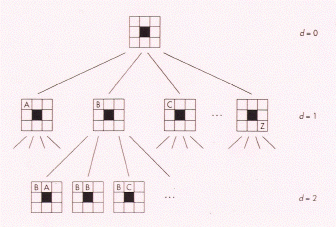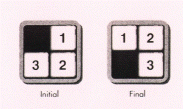Suppose that we wanted to build a "reflex" agent to play Tic-Tac-Toe. When this agent is given a board position, it will look its move up in a table of moves. How many entries will the agent need to have in its table? How would you go about finding the entries to store in this table?

How deep are the goal nodes this search space? Are there any states in the this diagram below which you would not expect to find a goal state?

One set of operators for this problem is { move blank right, move blank left, move blank up, move blank down }.
Draw the search space for this problem, assuming that whenever we have a choice between two operators we prefer to do them in the order listed above. Which goal state in the tree will depth-first search find? Breadth-first search?
- Tom is shorter than Karen.
- No one is taller than Wilt.
- Someone is taller than Karen.
- For any x and y, if x is taller than y then y is shorter than x.